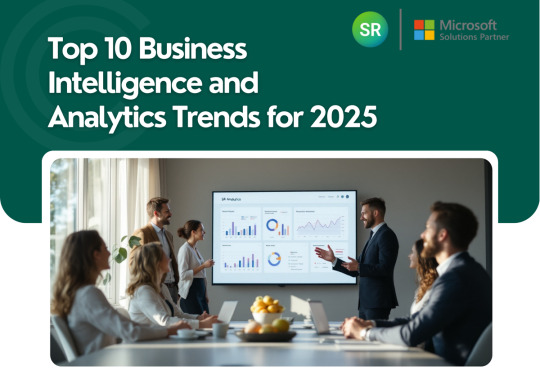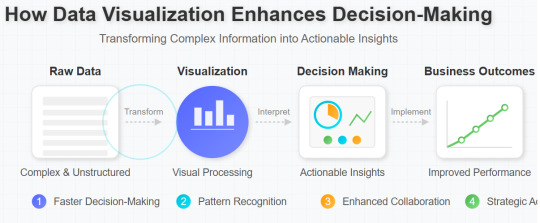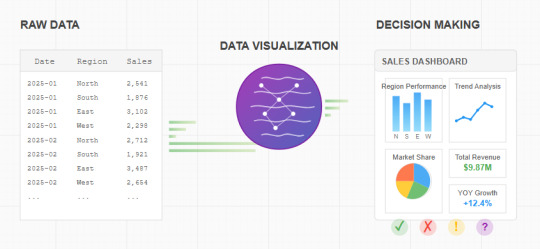#Data analytics consulting
Explore tagged Tumblr posts
Text
What is Customer Analytics? – The Importance of Understanding It
Consumers have clear expectations when selecting products or services. Business leaders need to understand what influences customer decisions. By leveraging advanced analytics and engaging in data analytics consulting, they can pinpoint these factors and improve customer experiences to boost client retention. This article will explore the importance of customer analytics.
Understanding Customer Analytics
Customer analytics involves applying computer science, statistical modeling, and consumer psychology to uncover the logical and emotional drivers behind consumer behavior. Businesses and sales teams can work with a customer analytics company to refine customer journey maps, leading to better conversion rates and higher profit margins. Furthermore, they can identify disliked product features, allowing them to improve or remove underperforming products and services.
Advanced statistical methods and machine learning (ML) models provide deeper insights into customer behavior, reducing the need for extensive documentation and trend analysis.
Why Customer Analytics is Essential
Reason 1 — Boosting Sales
Insights into consumer behavior help marketing, sales, and CRM teams attract more customers through effective advertisements, customer journey maps, and post-purchase support. Additionally, these insights, provided through data analytics consulting, can refine pricing and product innovation strategies, leading to improved sales outcomes.
Reason 2 — Automation
Advances in advanced analytics services have enhanced the use of ML models for evaluating customer sentiment, making pattern discovery more efficient. Consequently, manual efforts are now more manageable, as ML and AI facilitate automated behavioral insight extraction.
Reason 3 — Enhancing Long-Term Customer Relationships
Analytical models help identify the best experiences to strengthen customers’ positive associations with your brand. This results in better reception, positive word-of-mouth, and increased likelihood of customers reaching out to your support team rather than switching to competitors.
Reason 4 — Accurate Sales and Revenue Forecasting
Analytics reveal seasonal variations in consumer demand, impacting product lines or service packages. Data-driven financial projections, supported by data analytics consulting, become more reliable, helping corporations adjust production capacity to optimize their average revenue per user (ARPU).
Reason 5 — Reducing Costs
Cost per acquisition (CPA) measures the expense of acquiring a customer. A decrease in CPA signifies that conversions are becoming more cost-effective. Customer analytics solutions can enhance brand awareness and improve CPA. Benchmarking against historical CPA trends and experimenting with different acquisition strategies can help address inefficiencies and optimize marketing spend.
Reason 6 — Product Improvements
Customer analytics provides insights into features that can enhance engagement and satisfaction. Understanding why customers switch due to missing features or performance issues allows production and design teams to identify opportunities for innovation.
Reason 7 — Optimizing the Customer Journey
A customer journey map outlines all interaction points across sales funnels, complaint resolutions, and loyalty programs. Customer analytics helps prioritize these touchpoints based on their impact on engaging, retaining, and satisfying customers. Address risks such as payment issues or helpdesk errors by refining processes or implementing better CRM systems.
Conclusion
Understanding the importance of customer analytics is crucial for modern businesses. It offers significant benefits, including enhancing customer experience (CX), driving sales growth, and preventing revenue loss. Implementing effective strategies for CPA reduction and product performance is essential, along with exploring automation-compatible solutions to boost productivity. Customer insights drive optimization and brand loyalty, making collaboration with experienced analysts and engaging in data analytics consulting a valuable asset in overcoming inefficiencies in marketing, sales, and CRM.
3 notes
·
View notes
Text
Difference between data analysis and data analytics and data science
Data Analysis, Data Analytics, and Data Science are closely related fields but have distinct differences in their focus and methodologies. Here's an overview of each:
Data Analysis: Data analysis involves the process of inspecting, cleaning, transforming, and modeling data to derive meaningful insights and make informed decisions. It focuses on examining datasets to identify patterns, trends, and relationships. Data analysis often employs statistical techniques and tools to extract information from the data.
Data analysis typically involves:
Descriptive Analysis: Summarizing and describing data using statistical measures, charts, and graphs.
Exploratory Analysis: Exploring data to discover patterns, relationships, and outliers.
Inferential Analysis: Making inferences and drawing conclusions based on sample data to make predictions about a larger population.
Data Analytics: Data analytics expands on data analysis by incorporating advanced techniques and technologies to gain deeper insights into data. It involves the use of statistical modeling, machine learning, and data visualization tools to extract knowledge and draw conclusions. Data analytics focuses on answering specific business questions and solving problems.
Data analytics typically involves:
Predictive Analytics: Using historical data and statistical models to forecast future outcomes and trends.
Prescriptive Analytics: Recommending actions and strategies based on data insights to optimize business processes and decision-making.
Data Visualization: Presenting data in visual formats like charts, graphs, and dashboards to facilitate understanding and communication.
Data Science: Data science encompasses a broader set of skills and techniques that combine data analysis and analytics with elements of computer science and programming. It involves extracting knowledge and insights from complex and large-scale datasets through various methodologies, including statistical modeling, machine learning, data mining, and programming.
Data science typically involves:
Data Cleaning and Preprocessing: Preparing and transforming raw data for analysis.
Machine Learning: Developing and deploying algorithms to automatically learn from data and make predictions or decisions.
Big Data Analytics: Handling and analyzing large volumes of data that traditional methods may not be able to handle efficiently.
Data Engineering: Designing and implementing data pipelines, storage solutions, and database systems.
Deep Learning: Applying advanced neural networks to analyze and extract insights from complex data structures.
In summary, data analysis focuses on exploring and understanding data using statistical techniques, while data analytics involves using advanced tools and methodologies to gain actionable insights for decision-making. Data science encompasses a broader range of skills and techniques, combining data analysis and analytics with computer science to extract knowledge from complex datasets and solve complex problems.
Sources- https://us.sganalytics.com/data-management-analytics-services/

#data analytics services#data analytics solutions#data analytics services USA#Data Analytics Solutions USA#Data Analytics Consulting
2 notes
·
View notes
Text
10 Business Intelligence & Analytics Trends to Watch in 2025

Introduction
In 2025, business intelligence and analytics will have evolved from optional advantages to essential business drivers. Organizations leveraging advanced analytics consistently outperform competitors, with Forrester reporting that data-driven companies are achieving 30% annual growth rates.
We’ve witnessed a significant shift from simple descriptive analytics to AI-powered predictive and prescriptive models that don’t just report what happened but forecast what will happen and recommend optimal actions.
According to Gartner’s latest Analytics Magic Quadrant, organizations implementing advanced BI solutions are seeing a 23% improvement in operational efficiency and a 19% increase in revenue growth. As McKinsey notes, “The gap between analytics leaders and laggards is widening at an unprecedented rate.”

Trend 1: Augmented Analytics Goes Mainstream
Augmented analytics has matured from an emerging technology to a mainstream capability, with AI automating insight discovery, preparation, and visualization. Tools like Microsoft Power BI with Copilot and Tableau AI now generate complex analyses that previously required data science expertise.
A manufacturing client recently implemented augmented analytics and identified supply chain inefficiencies that saved $3.2M annually. These platforms reduce analysis time from weeks to minutes while uncovering insights human analysts might miss entirely.
Trend 2: Data Fabric and Unified Data Environments
Data fabric architecture has emerged as the solution to fragmented data environments. First popularized by Gartner in 2020, this approach creates a unified semantic layer across distributed data sources without forcing consolidation.
Organizations implementing data fabric are reporting 60% faster data access and 40% reduction in integration costs. For enterprises struggling with data silos across departments, cloud platforms, and legacy systems, data fabric provides a cohesive view while maintaining appropriate governance and security.
Trend 3: AI and ML-Driven Decision Intelligence
Decision intelligence — combining data science, business rules, and AI — has become the framework for optimizing decision-making processes. This approach transcends traditional analytics by not just providing insights but recommending and sometimes automating decisions.
Financial institutions are using decision intelligence for real-time fraud detection, reducing false positives by 37%. Retailers are optimizing inventory across thousands of SKUs with 93% accuracy. This shift is fundamentally changing organizational culture, moving from “highest-paid person’s opinion” to data-validated decision frameworks.
Trend 4: Self-Service BI for Non-Technical Users
The democratization of analytics continues with increasingly sophisticated self-service tools accessible to business users. Platforms like Qlik and Looker have evolved their interfaces to allow drag-and-drop analysis with guardrails that maintain data integrity.
This shift has reduced report backlogs by 71% for IT departments while increasing analytics adoption company-wide. The key enabler has been improved data literacy programs, with 63% of Fortune 1000 companies now investing in formal training to empower employees across all functions.
Trend 5: Real-Time and Embedded Analytics
Real-time, in-context insights are replacing static dashboards as analytics becomes embedded directly within business applications. Technologies like Kafka, Snowflake Streams, and Azure Synapse are processing millions of events per second to deliver insights at the moment of decision.
Supply chain managers are tracking shipments with minute-by-minute updates, IoT platforms are monitoring equipment performance in real-time, and financial services are detecting market opportunities within milliseconds. The “data-to-decision” window has compressed from days to seconds.
Trend 6: Data Governance, Privacy & Ethical AI
With regulations like GDPR, CCPA, and the EU AI Act now fully implemented, governance has become inseparable from analytics strategy. Leading organizations have established formal ethics committees and data stewardship programs to ensure compliance and ethical use of data.
Techniques for bias detection, algorithmic transparency, and explainable AI are now standard features in enterprise platforms. Organizations report that strong governance paradoxically accelerates innovation by establishing clear frameworks for responsible data use.
Trend 7: Cloud-Native BI and Multi-Cloud Strategies
Cloud-native analytics platforms have become the standard, offering scalability and performance impossible with on-premises solutions. Google BigQuery, Snowflake, and Azure Synapse lead the market with petabyte-scale processing capabilities.
Multi-cloud strategies are now the norm, with organizations deliberately distributing analytics workloads across providers for resilience, cost optimization, and specialized capabilities. Orchestration platforms are managing this complexity while ensuring consistent governance across environments.
Trend 8: Natural Language Processing in BI Tools
Conversational interfaces have transformed how users interact with data. “Ask a question” features in platforms like Tableau GPT, ThoughtSpot, and Microsoft Copilot allow users to query complex datasets using everyday language.
These NLP capabilities have expanded analytics access to entirely new user groups, with organizations reporting 78% higher engagement from business stakeholders. The ability to simply ask “Why did sales drop in the Northeast last quarter?” and receive instant analysis has made analytics truly accessible.
Trend 9: Composable Data & Analytics Architectures
Composable architecture — building analytics capabilities from interchangeable components — has replaced monolithic platforms. This modular approach allows organizations to assemble best-of-breed solutions tailored to specific needs.
Microservices and API-first design have enabled “analytics as a service” delivery models, where capabilities can be easily embedded into any business process. This flexibility has reduced vendor lock-in while accelerating time-to-value for new analytics initiatives.
Trend 10: Data Democratization Across Organizations
True data democratization extends beyond tools to encompass culture, training, and governance. Leading organizations have established data literacy as a core competency, with training programs specific to each department’s needs.
Platforms supporting broad access with appropriate guardrails have enabled safe, controlled democratization. The traditional analytics bottleneck has disappeared as domain experts can now directly explore data relevant to their function.
Future Outlook and Preparing for 2025
Looking beyond 2025, we see quantum analytics, autonomous AI agents, and edge intelligence emerging as next-generation capabilities. Organizations successfully navigating current trends will be positioned to adopt these technologies as they mature.
To prepare, businesses should:
Assess their BI maturity against industry benchmarks
Develop talent strategies for both technical and business-focused data roles
Establish clear use cases aligned with strategic priorities
Create governance frameworks that enable rather than restrict innovation
Final Thoughts
The analytics landscape of 2025 demands adaptability, agility, and effective human-AI collaboration. Organizations that embrace these trends will gain sustainable competitive advantages through faster, better decisions.
For a personalized assessment of your analytics readiness and a custom BI roadmap, contact SR Analytics today. Our experts can help you navigate these trends and implement solutions tailored to your specific business challenges.
#data analytics consulting company#data analytics consulting services#analytics consulting#data analytics consultant#data and analytics consultant#data analytics#data and analytics consulting#data analytics consulting
0 notes
Text
Data Analytics Consulting Services For Business Success
Most businesses today are sitting on a goldmine of data—yet they’re still making decisions based on gut feel or outdated reports. This disconnect doesn’t come from a lack of ambition, but from a lack of structure. That’s where data analytics consulting services step in—helping companies turn raw data into real business outcomes.
What Does a Data Analytics Consulting Firm Do?
A data analytics consulting firm helps organizations make sense of their data by:
Auditing current data systems and tools
Designing efficient data pipelines and dashboards
Enabling cross-functional teams to access reliable, real-time insights
At Dataplatr, we go beyond standard reporting. Our goal is to help businesses not just understand their data, but act on it with confidence.
Why Should Small Businesses Consider It?
Data analytics consulting for small businesses is more accessible than ever. Even with limited resources, small teams can:
Track meaningful KPIs, not vanity metrics
Use predictive analytics to plan ahead
Automate reporting and reduce manual effort
Understand customer behaviour in greater depth
The Importance of a Strong Data Strategy
Without a solid foundation, analytics won’t deliver value. Our data strategy consulting services help businesses:
Define what data matters—and why
Ensure accuracy, privacy, and compliance
Set up systems that scale as your business grows
Our Approach: Tailored to Fit Your Needs
We understand that no two businesses are the same. That’s why we offer:
Managed Services – We run the full analytics lifecycle so your team can focus on execution
Fractional Services – Access expert consultants without hiring full-time
Custom Analytics Services – Bespoke solutions built to meet your unique business challenges
Conclusion
At Dataplatr, we simplify the complex world of analytics. From startups to growing enterprises, we help businesses turn scattered data into a clear advantage—using the right mix of strategy, tools, and services. If you're looking to make smarter, faster decisions, we’re here to help.
0 notes
Text
Why Do Companies Need Data Analytics Consulting?
Data Analytics Consulting Services help businesses transform raw data into actionable insights, enabling smarter decision-making and boosting efficiency. In today's data-driven world, companies generate massive amounts of information, yet many struggle to use it effectively. Consulting services bridge this gap by offering expertise in data collection, trend analysis, and predictive modeling.
By leveraging data analytics, businesses can identify hidden patterns, optimize operations, and improve customer experiences. Consultants provide key services such as data visualization, AI-powered analytics, and tool integration to streamline workflows. Industries like retail, healthcare, and finance use these services to enhance supply chain management, reduce costs, and improve customer satisfaction.
Investing in data analytics consulting is not just an option—it’s a necessity for staying competitive. Whether improving marketing strategies or predicting future trends, data-driven insights help businesses make informed decisions and drive long-term success.

0 notes
Text
BI consulting services that empower your business with actionable insights. Enhance decision-making and drive growth through expert data analytics solutions.
#customer BI consulting company#customer BI consulting service#customer BI consulting in india#data analytics#data analytics consulting#data analytics consulting company#data analytics consulting services#data analytics consulting companies#ai company#consulting firms#gen ai#conversational ai#conversational ai companies
0 notes
Text
Unleashing the Power of Generative AI: The Role of Data Architecture and Data Analytics
Generative AI is revolutionizing industries, and Salesforce is at the forefront of this technological advancement. As businesses seek to harness the potential of generative AI, a robust data architecture and insightful data analytics are crucial. This blog explores how these elements, combined with the expertise of Salesforce consultants and data analytics consulting firms, can unlock the full power of generative AI.

Data Architecture: The Foundation of Generative AI
A well-designed data architecture is the bedrock for successful generative AI implementation. It involves organizing, storing, and managing data in a way that enables efficient access and analysis. Key considerations for data architecture in generative AI include:
Data Quality and Integrity: Ensuring data accuracy, completeness, and consistency is essential for training and fine-tuning AI models.
Data Security and Privacy: Implementing robust security measures to protect sensitive data is paramount, especially when dealing with personal information.
Data Governance: Establishing clear guidelines for data usage, access, and sharing helps maintain data quality and compliance.
Scalability and Flexibility: The data architecture should be designed to accommodate future growth and evolving AI needs.
Data Analytics: Driving Insights from Data
Data analytics plays a vital role in extracting valuable insights from vast datasets. By analyzing historical data, businesses can identify patterns, trends, and anomalies that can inform decision-making and improve AI model performance. Key data analytics techniques for generative AI include:
Exploratory Data Analysis (EDA): Uncovering hidden patterns and relationships within the data.
Predictive Analytics: Forecasting future trends and outcomes.
Prescriptive Analytics: Recommending optimal actions based on data-driven insights.
The Role of Salesforce Consultants and Data Analytics Consulting Firms
Salesforce consultants can help businesses leverage the power of Salesforce's generative AI driven capabilities, such as Einstein GPT, to automate tasks, improve customer experiences, and enhance sales and marketing efforts.
Data analytics consulting firms can provide expert guidance on data architecture, data quality, and data analytics techniques. They can also assist in building and deploying AI models, ensuring optimal performance and accuracy.
Conclusion:
By combining the expertise of Salesforce consultants and data analytics consulting firms, businesses can effectively harness the power of generative AI. A robust data architecture and insightful data analytics are essential for unlocking the full potential of this transformative technology.
HIKE2 is a leading provider of Salesforce and data analytics services. Our team of experts can help you navigate the complexities of generative AI and achieve your business goals.
#data analytics consulting#data architecture in generative AI#Salesforce Consultants#Salesforce's generative AI#Data analytics consulting firms
0 notes
Text
Cymetrix's Data Analytics Services

Getting overwhelmed by data that seems to cloud rather than clarify your strategic vision? You’re not alone, and the good news is that Cymetrix's Data Analytics services are here to transform that challenge into an opportunity. Our dedicated team specializes in translating complex datasets into valuable, actionable insights that propel your business forward. By leveraging advanced analytics, machine learning, and cutting-edge business intelligence tools, we provide tailor-made solutions, including predictive insights, customized dashboards, and real-time reporting that align perfectly with your specific goals. We will empower you to stay ahead of the competition by unlocking the full potential of your data. Trust Cymetrix to guide your business toward sustainable growth and success. Let us help you turn your data into a powerful asset that fosters innovation and drives results. Experience the difference today, with Cymetrix!
#cymetrix software#data analytics#data analytics services#data analytics company#cymetrix data analytics#data analytics consulting
0 notes
Text
Strategic Data Analytics Consulting to Propel Business Forward
Harness the power of your data with our expert Data Analytics Consulting Services. We specialize in transforming raw data into actionable insights, enabling your business to make informed decisions and drive growth. Our experienced team provides tailored strategies that address your unique challenges, ensuring you leverage data effectively for optimal results. Partner with us to unlock the full potential of your data through our professional consulting services.
0 notes
Text
Mastering Data Analytics: A Step-By-Step Guide
In this step-by-step guide, let’s explore the fascinating world of data analytics, providing you with valuable insights and practical tips to help you navigate this rapidly evolving field. Whether you're a seasoned professional or a newcomer to the world of data analytics, this blog is designed to equip you with the knowledge and skills needed to harness the power of data and make informed decisions.
Join us on this insightful journey as we unravel the intricacies of data analytics consulting and empower you to leverage its potential to drive success in your personal and professional endeavours.
Understanding Data Analytics
Understanding Data Analytics is a crucial step in the journey to harnessing the power of data. It involves analysing, interpreting, and deriving meaningful insights from raw data to make informed business decisions. This process is instrumental in helping businesses understand customer behaviour, market trends, and operational efficiency, ultimately leading to improved performance and profitability.
Utilising data analytics can further result in better strategic planning, optimised processes, and a competitive edge in the market. However, mastering data analytics requires proficiency in statistical analysis, data mining techniques, and data visualisation tools, making it a multifaceted and dynamic discipline.
Importance of Data Analytics
Understanding Data Analytics is essential as it empowers organisations to uncover valuable patterns and correlations within their data for actionable insights. It enables businesses to identify opportunities, mitigate risks, and streamline operations based on evidence-based decision-making.
Effective data analytics can enhance customer experience by personalising products/services and anticipating future needs and preferences. By leveraging data analytics, companies can gain a deeper understanding of their target audience and adapt their strategies accordingly. Mastering data analytics is a multifaceted and dynamic discipline that can significantly impact business performance and profitability.

Types of Data Analytics
The four main types of data analytics provide distinct insights and benefits to organisations. Descriptive analytics involves summarising historical data to understand past performance and trends, providing a snapshot of what has happened. Predictive analytics, on the other hand, utilises historical data to forecast future outcomes and trends, leveraging statistical models and machine learning algorithms to make informed predictions.
Meanwhile, prescriptive analytics goes a step further by recommending actions to optimise processes or solve problems based on insights derived from historical and real-time data. Lastly, diagnostic analytics aims to determine the root causes of past events or performance issues by examining historical data patterns, helping organisations understand why certain outcomes occurred. Each type of analytics plays a crucial role in harnessing the power of data to drive informed decision-making and improve business performance.
Acquiring Data Analytics Skills
To acquire data analytics skills, consider enrolling in online courses that cover essential concepts and tools. Practice analysing data sets using popular software such as Python, R, or SQL to gain practical experience.
Joining data analytics communities and forums can help you stay updated on industry trends and best practices, while seeking mentorship from experienced data analysts can provide valuable insights and guidance as you progress in your learning journey. These steps are essential for mastering data analytics and staying ahead in this dynamic field.
Learning Resources
Learning data analytics can be an exciting journey filled with numerous resources to help you master the craft. You can utilise online platforms such as Coursera, Udemy, or Khan Academy for comprehensive courses that cover essential data analytics concepts. Additionally, reading influential books on data analysis, statistics, and machine learning can provide in-depth knowledge and practical insights.
Exploring free resources like blogs, podcasts, and YouTube channels dedicated to data analytics can offer diverse perspectives and practical tips. Lastly, attending webinars, workshops, and conferences can further expand your understanding of data analytics concepts and connect you with industry experts for valuable insights. With these varied learning resources, mastering data analytics becomes an achievable goal.
Hands-On Experience
To gain hands-on experience in data analytics, consider participating in internships or volunteering for projects that involve real-world data analysis tasks. Additionally, you can utilise public datasets to independently practice cleaning, analysing, and visualising data.
Collaborating with peers on data-related projects can enhance your teamwork and problem-solving skills, while contributing to open-source projects provides practical scenarios to apply your data analytics skills. These practical experiences will supplement your learning and help you master data analytics through real-world applications.
Applying Data Analytics Techniques
Data analytics techniques play a crucial role in analysing large datasets to reveal valuable insights that drive informed decision-making. By applying these data analytics consulting techniques, businesses can uncover trends, patterns, and correlations within their data, ultimately enhancing strategic planning and overall performance.
The process involves various critical steps, including data cleaning, data transformation, and statistical analysis, which are essential for extracting meaningful information from raw data. It's no surprise that professionals proficient in these techniques are highly sought after across diverse industries, given their ability to drive innovation and optimise business processes.
Data Cleaning and Pre-processing
Data cleaning and pre-processing are crucial initial steps in the data analytics process. These steps involve identifying and rectifying errors, inconsistencies, and duplicates within the data to ensure its accuracy and reliability. Handling missing values, addressing outliers, and transforming the data into a usable format are all integral parts of this stage.
Proficiency in data cleaning and pre-processing is fundamental for obtaining high-quality analytical results, as it lays the groundwork for successful data analytics projects. By paying close attention to these steps, analysts can enhance the overall quality of insights derived from the dataset, setting the stage for impactful decision-making and strategic planning.
Data Visualisation and Interpretation
Data visualisation involves presenting information in graphical or visual format to effectively communicate insights derived from the analysed data. It enables stakeholders to comprehend complex datasets at a glance, facilitating quicker decision-making processes within organisations.
Through effective visualisation, trends, patterns, and relationships within the data can be easily interpreted, leading to actionable outcomes. Professionals skilled in data visualisation play a crucial role in conveying impactful narratives through visual representations of complex analytical findings. These visual representations help in conveying complex findings in a more digestible and impactful manner, ultimately driving informed decision-making and strategic planning.
Mastering Advanced Data Analytics
Mastering advanced data analytics encompasses understanding intricate statistical models and algorithms, which serve as the foundation for deriving valuable insights from complex datasets. Proficiency in programming languages such as Python, R, or SQL is vital for effectively manipulating and analysing data, enabling analysts to uncover meaningful patterns and correlations.
Furthermore, the ability to communicate findings and tell compelling stories with data is crucial in conveying insights to diverse stakeholders. Additionally, gaining practical experience in handling large datasets is essential for mastering advanced data analytics, as it provides valuable exposure to real-world challenges and scenarios, further refining analytical skills and expertise.
Predictive Analytics
Predictive analytics uses historical data and machine learning techniques to forecast future outcomes. It helps businesses make informed decisions by predicting trends and behaviour patterns. Regression analysis and time series modelling are common methods used in predictive analytics.
This type of analysis plays a vital role in optimising marketing strategies and reducing risks. By leveraging predictive analytics, businesses can gain valuable insights that drive strategic decision-making and enhance overall performance.
Machine Learning and AI
Machine learning algorithms enable systems to automatically learn and improve from experience without being explicitly programmed. This advancement in AI technology has led to applications such as natural language processing and image recognition, which are part of the machine learning landscape.
The primary types of machine learning approaches include supervised learning, unsupervised learning, and reinforcement learning, each playing a crucial role in powering innovations across various industries, from healthcare to finance. The combination of machine learning and AI continues to drive valuable advancements, revolutionising the way businesses and organisations leverage data to improve processes and decision-making.
Interpreting and Communicating Results
Interpreting and communicating the results of data analysis is a critical step towards driving informed decision-making processes. After analysing the data, it's crucial to draw meaningful insights that can provide valuable direction for strategic planning. Visual aids such as charts and graphs play a vital role in enhancing the communication of analytical findings to stakeholders, allowing for quick comprehension of complex datasets.
Additionally, utilising storytelling techniques can make the communication of results more engaging and easier to comprehend, effectively conveying the narrative behind the data. Presenting both quantitative and qualitative data is essential for a comprehensive understanding of the analysed results, ensuring that all aspects of the findings are effectively communicated and understood by diverse stakeholders.
Drawing Insights from Analysed Data
Drawing insights from analysed data involves identifying trends and patterns to uncover valuable insights. Utilising advanced statistical methods can reveal hidden correlations within the dataset, leading to impactful findings.
It is crucial to validate the accuracy of analysed data to ensure the reliability and trustworthiness of the insights drawn. Additionally, collaborating with domain experts can provide valuable context for interpreting the analysed data effectively, enhancing the depth and quality of the insights gained.
Effective Communication of Findings
Crafting clear and concise messages is essential for effectively communicating analytical findings to diverse audiences. Tailoring the communication style to match the audience's level of understanding facilitates better comprehension of findings.
Encouraging open discussions after presenting findings fosters a collaborative approach towards decision-making based on data. Leveraging visualisation tools like dashboards can simplify complex findings for easier digestion by non-technical stakeholders. These strategies ensure that the communicated insights are not only understood but also contribute to informed decision-making processes.
Final Words
Mastering data analytics involves understanding its importance and the different types of analytics. Acquiring the necessary skills through learning resources and hands-on experience is crucial for applying data analytics techniques effectively.
Additionally, interpreting and communicating results, drawing insights from analysed data, and effectively communicating findings are essential steps in leveraging advanced data analytics.
Furthermore, predictive analytics, machine learning, and AI play significant roles in driving strategic decision-making and innovation. By mastering these advanced techniques and effectively communicating findings, businesses can gain valuable insights, optimise strategies, and improve overall performance. It is evident that data analytics consulting has become an indispensable tool for businesses seeking to thrive in today's data-driven landscape.
Source URL: https://ivedatadriven.blogspot.com/2024/05/mastering-data-analytics-step-by-step.html
0 notes
Text
Solutions and Consulting Services for Data Analytics
Introduction to Data Analytics Consulting
Businesses now must overcome the issue of gleaning insightful information from massive amounts of data in a data-driven society. In order to assist businesses use data to make wise decisions and spur expansion, data analytics consulting services are essential. Companies in a variety of industries, from small startups to huge corporations, are turning to data analytics consulting businesses for advice and assistance.

Importance of Data Analytics Consulting Services
Data analytics consulting services are essential for businesses looking to gain a competitive edge in their respective industries. These services help organizations uncover patterns, trends, and correlations within their data, enabling them to optimize processes, improve efficiency, and enhance decision-making. By leveraging advanced analytics techniques, businesses can identify opportunities for revenue growth, cost reduction, and risk mitigation.
Types of Data Analytics Consulting Solutions
Descriptive Analytics
Descriptive analytics involves analyzing historical data to understand what has happened in the past. It provides valuable insights into trends, patterns, and anomalies, allowing businesses to gain a better understanding of their current situation.
Predictive Analytics
Predictive analytics utilizes statistical algorithms and machine learning techniques to forecast future outcomes based on historical data. By identifying patterns and trends, predictive analytics helps businesses anticipate customer behavior, market trends, and potential risks.
Prescriptive Analytics
Prescriptive analytics goes beyond predicting future outcomes by recommending actions to optimize decision-making. By analyzing data in real-time, prescriptive analytics helps businesses identify the best course of action to achieve their goals and objectives.
Benefits of Data Analytics Consulting Services
Improved Decision Making: By providing actionable insights, data analytics consulting services enable businesses to make informed decisions.
Enhanced Efficiency: By automating repetitive tasks and streamlining processes, data analytics solutions help businesses operate more efficiently.
Competitive Advantage: By leveraging data-driven insights, businesses can gain a competitive edge in their respective industries.
Cost Savings: By identifying areas for optimization and resource allocation, data analytics consulting services help businesses reduce costs and increase profitability.

Industries Utilizing Data Analytics Consulting
Data analytics consulting services are utilized across various industries, including:
Healthcare
Finance
Retail
Manufacturing
Telecommunications
Marketing
Real Estate
Pharmaceutical
Insurance
Asset Management
Logistics
CPG
E-commerce
Retail
Oil and Gas
Tyre
Cement
Insurance
NBFC
Asset Management
How to Choose the Right Data Analytics Consulting Firm
When selecting a data analytics consulting firm, businesses should consider factors such as expertise, experience, and industry knowledge. It’s essential to choose a firm that understands the unique challenges and opportunities within your industry and can tailor solutions to meet your specific needs.
Case Studies: Successful Implementation of Data Analytics Solutions
Company A: Increased sales by 20% after implementing predictive analytics to forecast customer demand.
Company B: Reduced operational costs by 15% by optimizing supply chain management processes using descriptive analytics.
Company C: Improved customer satisfaction by 25% by leveraging prescriptive analytics to personalize marketing campaigns.
**Learn Data Analytics Case Studies**
Challenges in Data Analytics Consulting
Despite the numerous benefits, data analytics consulting also presents challenges such as:
Data Quality: Ensuring the accuracy and reliability of data sources.
Data Security: Protecting sensitive information from breaches and cyber-attacks.
Talent Shortage: Finding skilled data analysts and scientists to interpret and analyze data effectively.
Future Trends in Data Analytics Consulting
The future of data analytics consulting is shaped by emerging technologies such as artificial intelligence, machine learning, and the Internet of Things. These advancements enable businesses to collect, analyze, and interpret data more efficiently, unlocking new opportunities for innovation and growth.
Conclusion
Data analytics consulting services are essential for businesses looking to thrive in today’s data-driven economy. By harnessing the power of data analytics, organizations can gain valuable insights, improve decision-making, and drive sustainable growth.
FAQs
What are data analytics consulting services?
Data analytics consulting services involve helping businesses analyze and interpret data to make informed decisions and drive growth.
How can data analytics consulting services benefit my business?
Data analytics consulting services can improve decision-making, enhance efficiency, and provide a competitive advantage by leveraging data-driven insights.
What industries utilize data analytics consulting services?
Industries such as healthcare, finance, retail, manufacturing, telecommunications, and marketing utilize data analytics consulting services.
What are the challenges in data analytics consulting?
Challenges include data quality issues, data security concerns, and a shortage of skilled talent in the field of data analytics.
What are the future trends in data analytics consulting?
Future trends include the integration of artificial intelligence, machine learning, and the Internet of Things to unlock new opportunities for innovation and growth.
#data analytics#data analytics consulting services#data analytics consulting#data analytics solutions#data analytics consulting firm
0 notes
Text
How Data Visualization Enhances Decision-Making: A Comprehensive Guide

In today’s data-driven business landscape, organizations are drowning in information but starving for insights. As the volume and complexity of data continue to grow exponentially, the ability to transform raw numbers into actionable intelligence has become a critical competitive advantage.
Data visualization stands at the forefront of this transformation, offering powerful tools to enhance decision-making processes across industries.
Understanding Data Visualization in Modern Business
Data visualization is the graphical representation of information and data using visual elements like charts, graphs, and maps. What began as simple bar charts and pie diagrams has evolved into interactive dashboards and immersive visual experiences that reveal patterns, correlations, and trends that might otherwise remain buried in spreadsheets.
According to research from MIT, the human brain processes visual information 60,000 times faster than text.
This cognitive advantage explains why well-designed visualizations can dramatically accelerate understanding and decision-making in complex scenarios. In an era where time-to-decision directly impacts business outcomes, visualization has become essential rather than optional.
The Cognitive Impact of Visual Data Processing
Our brains are wired to process visual information more efficiently than text or numbers. This phenomenon, known as “preattentive processing,” allows us to grasp certain visual attributes — color, size, shape, and motion — almost instantaneously, without conscious effort.
Studies have consistently shown that people remember only about 10% of what they hear and 20% of what they read, but nearly 80% of what they see and do.
By leveraging this cognitive advantage, data visualization reduces the mental workload required to process complex information, allowing decision-makers to:
Quickly identify patterns and anomalies
Understand relationships between variables
Retain insights longer and more accurately
Share a common understanding across teams
How Visualization Transforms Decision-Making Processes

Accelerating Time-to-Decision
In competitive business environments, the speed of decision-making can be as important as the quality. Visualization dramatically reduces the time required to analyze and understand complex data sets.
For example, a global manufacturing company implemented real-time production dashboards across its facilities and reduced decision response time by 58%.
When quality issues appeared on the visualization, floor managers could immediately identify and address problems rather than waiting for end-of-day reports.
“Before implementing visualization tools, our weekly analysis meetings would last three hours as we pored over spreadsheets,” explains Sarah Chen, Chief Data Officer at a Fortune 500 financial services firm. “Now, with our interactive dashboards, we identify key insights in under 30 minutes and spend the rest of our time on strategic decisions rather than data interpretation.”
Discover -> Bad Data Visualization Examples
Enhancing Focus on Critical Insights
The human attention span is limited, making focus a precious commodity. Well-designed visualizations focus on what matters most, filtering out noise and highlighting significant patterns.
Consider healthcare settings, where patient monitoring generates enormous volumes of data. Visualization tools that highlight vital sign anomalies enable clinicians to identify patients requiring immediate attention quickly.
One hospital system reported a 23% improvement in early intervention after implementing visualization-based monitoring, directly improving patient outcomes.
Uncovering Hidden Patterns and Relationships
Some insights simply cannot be discovered without visualization. Complex relationships between variables often remain invisible in traditional reports but become immediately apparent when visualized effectively.
A retail chain analyzing customer behavior discovered an unexpected correlation between weather patterns and certain product categories only after visualizing their sales data geospatially.
This insight led to a dynamic inventory management system that increased seasonal product availability by 34% while reducing overstock by 27%.
Improving Collaborative Decision-Making
When teams share visualizations, they develop a common understanding that transcends departments and technical expertise.
Marketing teams can understand supply chain constraints; finance can appreciate customer experience metrics; executives can grasp technical challenges — all through the universal language of visual representation.
Real-World Applications Across Industries
Financial Services: Risk Visualization and Fraud Detection
Financial institutions handle massive data volumes while operating in highly regulated environments where risks must be carefully managed. Interactive heat maps and network visualizations help analysts quickly identify suspicious patterns that might indicate fraud.
JPMorgan Chase’s fraud detection systems reportedly process 5 million transactions daily, using visualization to highlight potential fraud patterns that would be impossible to detect manually. Their visualization-powered systems have improved fraud detection rates by over 30% while reducing false positives.
Healthcare: Improving Patient Outcomes Through Visual Analytics
Healthcare providers increasingly rely on visualization to manage patient populations and improve clinical outcomes. Visualizing patient data across demographics, conditions, and treatments helps identify high-risk patients and optimize care protocols.
Cleveland Clinic implemented visualization dashboards to monitor readmission risk factors, resulting in a 21% reduction in preventable readmissions.
Clinicians could visually identify which post-discharge interventions were most effective for specific patient populations, allowing for more personalized care planning.
Marketing: Customer Journey Visualization
Modern marketing generates vast data across multiple touchpoints. Visualization tools help marketers understand the complex customer journey and identify opportunities for engagement.
An e-commerce company used journey visualization to discover that customers who engaged with their mobile app within three days of website browsing were 67% more likely to complete a purchase.
This insight led to targeted app download prompts that increased conversion rates by 24%.
Discover -> Worth Investing In Data Visualization Tools For SMEs
Avoiding Common Visualization Pitfalls
Despite its power, data visualization can mislead when implemented poorly. Common pitfalls include:
Misleading scales and proportions: Manipulating axis scales can dramatically change perceptions
Correlation confusion: Visualization might suggest causation where only correlation exists
Overcomplication: Adding too many variables to a single visualization reduces clarity
Cherry-picking data: Selecting only data points that support a preferred narrative

To maintain integrity, organizations should establish visualization standards and train teams in visual literacy — the ability to read, interpret, and create visual representations of data.
The Future of Decision-Making Through Visualization
As technology advances, visualization continues to evolve. Emerging trends include:
Augmented analytics: AI-powered systems that automatically identify and highlight noteworthy patterns
Immersive visualization: VR/AR environments where users can “walk through” their data
Natural language interfaces: Systems that generate visualizations in response to conversational queries
Real-time, collaborative visualization: Platforms that enable multiple stakeholders to interact with live data simultaneously
Conclusion: Translating Visual Insights into Action
Data visualization’s true value lies not in creating beautiful graphics but in driving better decisions. Organizations that develop a visualization strategy aligned with their decision-making needs gain a significant competitive edge.
By reducing cognitive load, highlighting critical insights, uncovering hidden patterns, and fostering collaboration, data visualization transforms information overload into decision-making clarity.
In a business environment where the quality and speed of decisions directly impact success, the ability to effectively visualize data has become an essential capability rather than a nice-to-have skill.
As you consider your organization’s approach to data, remember that the most sophisticated analysis provides little value if key decision-makers cannot understand and act upon it. Effective visualization bridges this gap, ensuring that your data doesn’t just inform — it transforms.
#data analytics consulting services#data analytics consulting company#analytics consulting#data analytics consultant#data and analytics consultant#data analytics#data analytics consulting#data and analytics consulting
0 notes
Text
Discover how data analytics consulting can revolutionize your business performance. From predictive insights to operational efficiency, unlock growth opportunities with top-tier data analytics services in Dubai. Learn more!
#data analytics#data analytics services#data analytics consulting#data analytics company#data analytics strategy
0 notes
Text
Business Technology Solutions: Innovations in Technology Consulting

Introduction:
In today's fast-paced business landscape, staying ahead requires not only embracing change but also leveraging cutting-edge technologies. Business technology solutions play a pivotal role in empowering organizations to adapt, innovate, and thrive in an increasingly digital world. This article delves into the transformative impact of technology consulting, exploring key areas such as cloud computing, IT disaster recovery planning, data analytics, digital transformation, and more.
1. Cloud Computing Consultancy:
One of the most significant advancements in recent years is the widespread adoption of cloud computing. Businesses are increasingly turning to cloud solutions for their scalability, flexibility, and cost-effectiveness. Cloud computing consultancy services guide organizations in selecting, implementing, and optimizing cloud infrastructure tailored to their specific needs. Whether it's public, private, or hybrid cloud models, technology consulting firms provide expertise in navigating the complexities of cloud adoption.
2. IT Disaster Recovery Planning:
In the face of unforeseen disruptions, IT disaster recovery planning is crucial for maintaining business continuity. Technology consulting services specializing in disaster recovery assist organizations in developing robust strategies to ensure data integrity and system availability. From risk assessments to creating comprehensive recovery plans, business technology advisors play a vital role in safeguarding against potential threats, minimizing downtime, and protecting critical business operations.
3. Data Analytics Consulting:
Data is often referred to as the new currency, and harnessing its power is imperative for informed decision-making. Data analytics consulting services help businesses unlock the potential of their data by implementing advanced analytics tools and techniques. From predictive modeling to business intelligence, technology consulting firms enable organizations to derive actionable insights, drive innovation, and gain a competitive edge in their respective industries.
4. Digital Transformation Consulting:
In the era of digital disruption, embracing change is not just a choice but a necessity. Digital transformation consulting services assist businesses in reimagining their processes, culture, and customer experiences. By leveraging emerging technologies, such as artificial intelligence, machine learning, and the Internet of Things, organizations can streamline operations, enhance customer engagement, and position themselves as industry leaders.
5. Information Technology Consulting:
As technology continues to evolve, staying abreast of the latest trends and innovations is paramount. Information technology consulting services provide organizations with strategic guidance on adopting and managing technologies that align with their business goals. From IT risk management to software development consulting, these services encompass a wide array of expertise to address the diverse technology needs of modern enterprises.
Conclusion:
In the dynamic landscape of business technology solutions, organizations must be proactive in leveraging innovative consulting services to stay competitive. Cloud computing, IT disaster recovery planning, data analytics, digital transformation, and information technology consulting are integral components in shaping the future of businesses. Collaborating with technology consulting firms and business technology advisors is not just a strategic choice; it's a commitment to embracing the transformative power of technology for sustained success. In a world driven by innovation, those who harness the potential of these solutions are poised to lead the way into the digital future.
#cloud computing#it disaster recovery planning#business technology solutions#cloud computing consultancy#data analytics consulting#digital transformation consulting#it risk management#software development consulting#technology consulting firms#technology consulting services#business technology advisors#data management consulting#technology consulting
0 notes
Text
Turn data into actionable insights. Our Business Intelligence consulting services help you unlock the power of your data to make informed decisions, optimize processes, and gain a competitive edge.
#bi consulting services#business intelligence services#business intelligence company#business intelligence and analytics#bi solutions#business intelligence analytics#data analytics company#data analysis services#ai for business intelligence#business intelligence consulting services#data analytics solutions#data analytics consulting#data analytics
0 notes